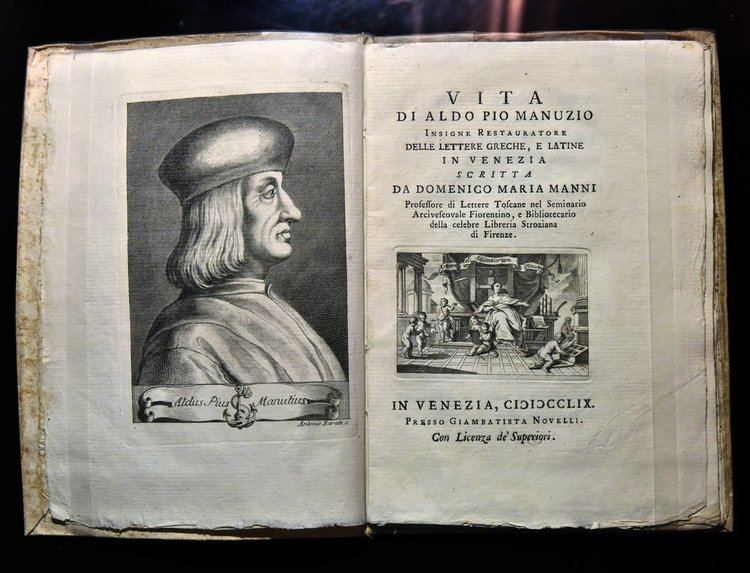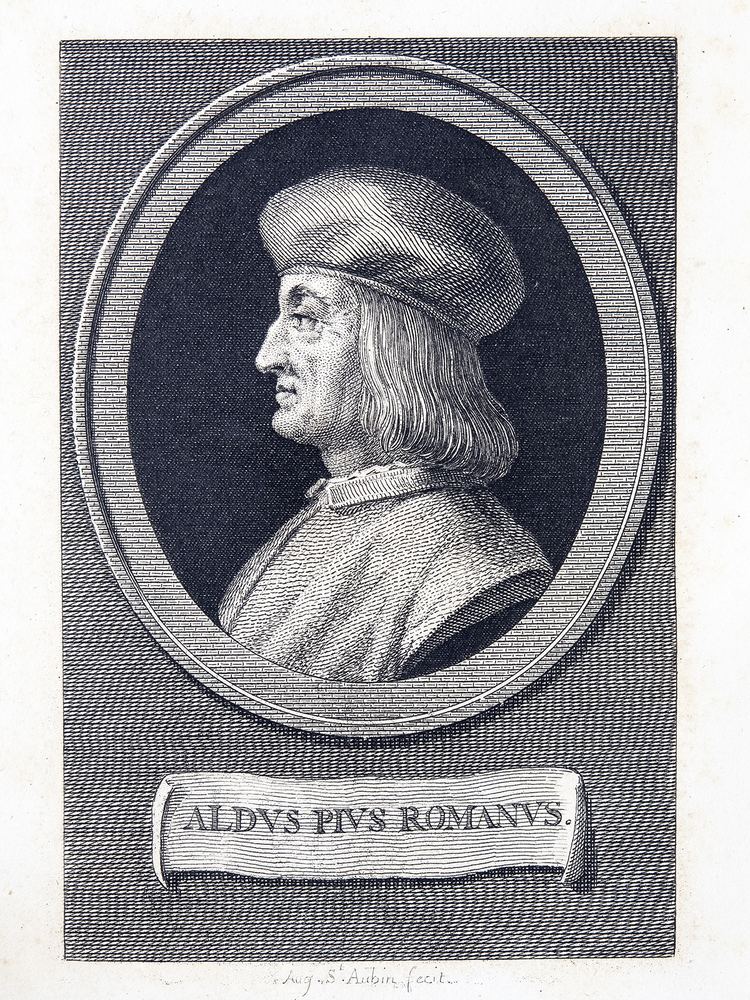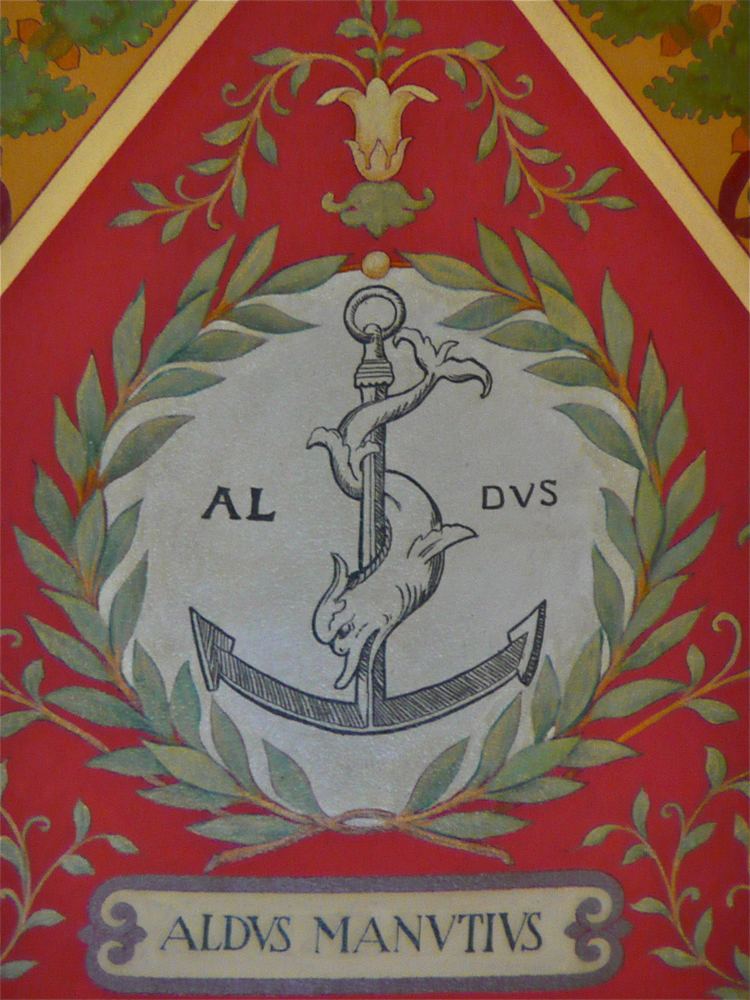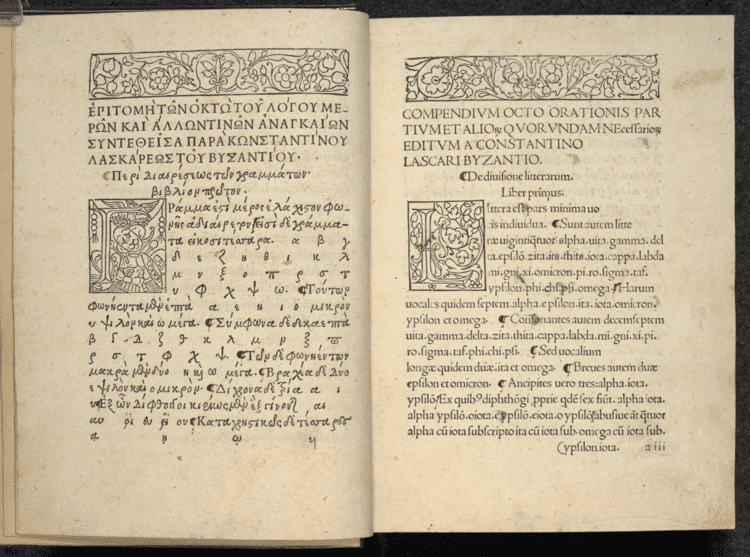Full Name Aldo Manuzio Children Paulus Manutius | Name Aldus Manutius Nationality Venetian | |
 | ||
Other names Aldus Manutius the Elder Occupation humanist who became a printer and publisher Books The Greek Classics, Aldus Manutius and his Thesaurus cornucopiae of 1496 Similar People | ||
Organizations founded Aldine Press | ||
Robin sloan aldus manutius and the invention of reading spark camp story hour
Aldus Pius Manutius also known as Aldo Manuzio (Italian: Aldo Pio Manuzio; ca. 1452 – February 6, 1515) was a Venetian humanist, scholar, educator, who became a printer and publisher when he helped found the Aldine Press in Venice, 1495. He is also known as "Aldus Manutius the Elder" to distinguish him from his grandson, "Aldus Manutius the Younger".
Contents
- Robin sloan aldus manutius and the invention of reading spark camp story hour
- Aldus Manutius
- Early life and printing press
- Aldine Press
- Greek classics
- Latin classics
- Imprint and motto
- The movable book Alduss octavos
- Typefaces
- Marriage and personal life
- Influence in the modern era
- References to Aldus Manutius
- Publications
- Archives
- References

Manutius "attempted to make classical Greek works accessible which before him had never been published in their original language". His publishing legacy includes the distinctions of inventing the first italic type, establishing the modern use of the semicolon, developing the modern appearance of the comma, and popularizing the libelli portatiles, or portable little (specifically) classic books: small-format volumes that could be easily carried and read anywhere.

Aldus Manutius
Early life and printing press

Manutius was born in Bassiano, in the Papal States, in what is now the province of Latina, some 100 km south of Rome, during the Italian Renaissance period. His family was well off and in the early 1470s Manutius was sent to Rome to be educated as a humanistic scholar, studying Latin under Gaspare da Verona and attending lectures by Domizio Calderini. In 1475–1478 he studied Greek in Ferrara, under Guarino da Verona.

Manutius was granted citizenship of the town Carpi in March 1480. In 1482 he went to reside at Mirandola with his old friend and fellow student, the illustrious Giovanni Pico, while avoiding the Venetian army. There he stayed two years, pursuing his studies in Greek literature. Before Pico moved to Florence, he procured for Manutius the post of tutor to his nephews, Alberto and Leonello Pio, princes of the town of Carpi. In Carpi, Manutius shared a close bond with his student, Alberto Pio. At the end of the 1480s Manutius published two works addressed to his two pupils and their mother, Caterina Pico. Both works were published by Baptista de Tortis in Venice — Musarum panagyris with its Epistola Catherinae Piae, March/May 1487 – March 1491 and the Paraenesis, 1490. This would serve as Manutius's emergence into the publishing sphere.

Giovanni Pico's family supplied Manutius with funds for starting his printing press and gave him lands at Carpi. Manutius settled in Venice in 1490. The same year, Manutius began gathering contracts and eventually met Andrea Torresani who also had come to Venice to become a print publisher. The two became lifelong business partners. For their first contract together, Manutius hired Torresani to print the first edition of his Latin grammar book, the Institutiones grammaticar published on March 9, 1493.
Aldine Press

In 1494 Manutius founded the Aldine Press in Venice. Yet, it wasn't until February 1495 that the Aldine Press had its first publication. The Aldine Press was owned half by Pier Francesco Barbarigo, whose uncle was the doge, Agostino Barbarigo. The other half was owned by Andrea Torresani. Manutius owned 1/5 of Torresani's share. Aldus Manutius desired to preserve ancient Greek literature and make it accessible to everyday people by printing editions of Greek classics. He wanted typefaces designed to look like the handwriting of humanists, both in Latin and Greek. Cursive was the norm for everyday handwriting in Venice, but at the time, published works only contained block lettering. By creating a cursive typeface, Manutius could make the works he published more personal. Manutius hired Francesco Griffo of Bologna as the punch cutter to create the new typeface "and the resulting roman face was first used to print Cardinal Pietro Bembo's De Aetna in 1495." This roman face was also the first model of italic type and used until 1501.
Greek classics
Before Manutius, four Italian towns had printed editions of ancient Greek texts: Milan, with the grammar of Constantine Lascaris, Aesop, Theocritus, a Greek Psalter, and Isocrates, between 1476 and 1493; Venice, with the Erotemata of Manuel Chrysoloras in 1484; Vicenza, with reprints of Lascaris' grammar and the Erotemata, in 1488 and 1490; and Florence, with Lorenzo de Alopa's Homer, in 1488. Of these works, only three, the Milanese Theocritus and Isocrates, and the Florentine Homer, were classics.
Venice, by this time, was not only a major printing center but it also had a large library of Greek manuscripts from Constantinople and a population of Greeks who could assist with their translation. He soon printed editions of Hero and Leander by Musaeus Grammaticus, the Galeomyomachia, and the Greek Psalter. He called these "Precursors of the Greek Library." He began gathering Greek scholars and compositors, employing as many as 30 Greeks in his print shop and speaking Greek at home. Instructions to typesetters and binders were given in Greek. The prefaces to his editions were written in Greek. Greeks from Crete collated manuscripts, read proofs, and gave samples of calligraphy for casts of Greek type.
In 1495, Manutius issued the first volume of his edition of Aristotle. Four more volumes completed the work in 1497–1498. Nine comedies of Aristophanes appeared in 1498. Thucydides, Sophocles, and Herodotus followed in 1502; Xenophon's Hellenics and Euripides in 1503; Demosthenes in 1504. It is possible that during this period, in his printing works, Hieromonk Makarije was educated, who later founded the Obod printing works of Cetinje and print the first books in Serbian and Romanian.
The Second Italian War, which pressed heavily on Venice, suspended Manutius' labors for a time. In 1508 he resumed his series with an edition of the minor Greek orators and in 1509 printed the lesser works of Plutarch. Printing work stopped again when the League of Cambrai drove Venice back to its lagoons, and all the forces of the republic were concentrated on a life-or-death struggle with the allied powers of Europe. In 1513, Manutius reappeared with an edition of Plato, which he dedicated to Pope Leo X in a preface that compares the miseries of warfare and the woes of Italy with the sublime and tranquil objects of the student's life. Pindar, Hesychius, and Athenaeus followed in 1514. At the end of his life, Manutius had begun an edition of the Septuagint, the first to be published; it appeared posthumously in 1518.
In addition to editing Greek classics from manuscripts, Manutius re-printed editions of classics that had originally been published in Florence, Rome, and Milan, at times correcting and improving the texts. To promote Greek studies, Manutius founded an academy of Hellenists in 1502 called the "New Academy." Its rules were written in Greek, its members were obliged to speak Greek, their names were Hellenized, and their official titles were Greek. Members of the "New Academy" included Desiderius Erasmus and the Englishman Thomas Linacre.
Latin classics
Manutius's press also published Latin and Italian classics. The Asolani of Bembo, the collected writings of Poliziano, the Hypnerotomachia Poliphili, Dante's Divine Comedy, Petrarch's poems, a collection of early Latin poets of the Christian era, the letters of the Pliny the Younger, the poems of Iovianus Pontanus, Jacopo Sannazaro's Arcadia, Quintilian, Valerius Maximus, and the Adagia of Erasmus were printed, either in first editions. As Symonds' Encyclopædia Britannica wrote, "with a beauty of type and paper never reached before, between the years 1495 and 1514". For these Italian and Latin editions, Manutius had the elegant type struck which bears his name. It is said to have been copied from Petrarch's handwriting, and was cast under the direction of Francesco da Bologna, who has been wrongly identified by Antonio Panizzi with Francia the painter.
The 1501 Virgil, which introduced the use of italic print, was produced in higher-than-normal print runs (1,000 rather than the usual 200 to 500 copies).
Manutius strove for excellence in typography and book design while at the same time striving to create inexpensive editions. His great undertaking was carried on under continual difficulties, arising from strikes among his workmen, the piracies of rivals, and the interruptions of war.
Imprint and motto
In 1501, Aldus began to use as his publisher's device, the image of a dolphin wrapped around an anchor. "The dolphin and anchor device owed its origins, most immediately to Pietro Bembo. Aldus was to tell Erasmus six years later that Bembo had given him a silver coin minted under the Emperor Vespasian and bearing an image of this device" His editions of the classics were so highly respected that almost immediately the dolphin-and-anchor device was pirated by French and Italian publishers. More recently, the device has been used by the nineteenth-century London firm of William Pickering, and by Doubleday. The dolphin and anchor emblem is associated with "Festina lente" which means "make haste slowly", a motto that Aldus had begun to use as early as 1499, after receiving the Roman coin from Pietro Bembo, bearing the emblem and motto.
The international honor society for library & information science, Beta Phi Mu uses the dolphin and the anchor as the society’s insignia.
The "movable book": Aldus's octavos
The development of the "movable book" is arguably Aldus’ most celebrated contribution to printing and publishing. His famous octavo editions have often been regarded as the first prototype of the mass-market trade paperback, but this popular idea is misleading and requires some clarification. "Aldus changed the format of the Latin [and Greek] classics in several ways. He published them without commentary and in smaller sizes, usually octavos of five by eight of four by six inches". Manutius's genius for the "movable book" was listening to his audience. At the time many publishers added commentary to the classics they published. Pages became overloaded with scholarship and serious material. Although "these innovations were not absolutely original with Aldus, their use in combination was". Manutius’ octavos were, also, moderately priced, considering the known average salaries of the time, but it would be a mistake to label them as "cheap." His portable books became known as the first appearance of editio minor, a straightforward text.
Typefaces
In the New Aldine Studies, Fletcher describes his belief for Manutius's typeface, "His principal intent, I am convinced, was to make available in type a face comfortable for its readers". Manutius designed a new font in which the letters were inclined which he called "italic" in reference to classical Italy. Type designs based on work designed by Francesco Griffo and commissioned by Aldus Manutius include Bembo, Poliphilus, and Garamond. Despite trying to have the font patented, he could not stop printers outside Venice from copying it, leading to the font's popularity outside of Italy.
Marriage and personal life
In 1505, Manutius married Maria, daughter of Andrea Torresani of Asola. Torresani and Manutius were already business partners but the marriage combined the two partner's shares in the publishing business. After the marriage, Manutius lived at Toressani's house, now his father-in-law. By 1506 the Aldine Press was shrinking in popularity and was moved to a house now covered by a bank building named Campo Manin. In March 1506 Manutius decided to travel from Venice in search of reliable manuscripts for six months. While travelling with Frederico de Ceresara, they were stopped by border guards of the marquisate of Mantua. The guards were looking for two criminals. In fear, Frederico took flight taking with him all of Manutius's personal effects, leaving the guards in high suspicion. They arrested Manutius. However, Manutius knew the Marquis of Mantua, Francesco Gonzaga. Manutius spent five days in jail in Casal Romano and spent another night in a real prison in Canneto. He wrote letters to the marquis but it took six days until it was brought to Gonzaga's attention. Manutius was released by Geoffroy Carles, president of the Milanese Senate. This experience brought forth the "eventual appearance, in 1509, of a new edition of Horace with an accompanying work by Aldus on Horation metrics, dedicated to Carles".
Manutius died in 1515, "with his death the importance of Italy as a seminal and dynamic force in printing came to an end" Torresani and his two sons carried on the business during the minority of Manutius' children. The device of the dolphin and the anchor, and the motto festina lente, which indicated quickness combined with firmness in the execution of a great scheme, were never wholly abandoned by the Aldine Press until the expiration of their firm in the third generation. Manutius dreamed of a trilingual Bible but never saw if come to fruition.
Influence in the modern era
1994 marks the 500th anniversary of Aldus Manutius' first publication. On Manutius, Paul F. Grendler wrote, "Aldus ensured the survival of a large number of ancient texts and greatly facilitated the diffusion of the values, enthusiasms, and scholarship of Italian Renaissance Humanism to the rest of Europe". "He jettisoned commentary because he felt that it prevented the dialogue between author and reader that the renaissance prized." The modern world owes a great debt to Aldus Manutius for Greek literature.
References to Aldus Manutius
Publications
Partial list of works published by the Aldine Press under Aldus Manutius's supervision:
Archives
For substantial collections of Aldus Manutius's publications, see Aldine Press Collections.
